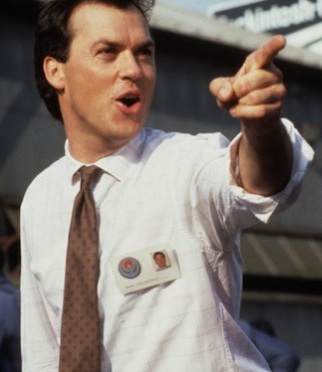Sunday, March 16, 1986.
GUNG HO. Written by Lowell Ganz and Babaloo Mandel. Music by Thomas Newman. Directed by Ron Howard. Running time: 111 minutes. Mature entertainment with the B.C. Classifier’s warning: some coarse language.
FIRST HADLEYVILLE LOST ITS underwear factory. For two years, there’ve been no bargain briefs from the factory store.
Nine months ago the auto plant shut down. Since then, “the only one who’s doing well is the guy who rents the U-Hauls.”
Fear not. Hunt Stevenson (Michael Keaton) has a better idea.
So what if domestic capital has turned its back on the former foreman, his friends and his co-workers? He’s off to Tokyo to convince Japan’s Assan Motors that a town full of Gung Ho Americans is an opportunity it can’t afford to miss.
Last year, [1985] there was talk of a Ron Howard “touch.” A former child star and teen actor who had taken up film direction, the adult Howard was performing like a born hit maker.
His first four theatrical features were boxoffice winners, pictures that offered an illusion of substance underscored by real warmth and good will. Comedies all, Howard’s pictures were suffused with a gentle romanticism, especially his hugely successful fantasies, 1984’s Splash and Cocoon (1985).
Suddenly “the touch” is gone. Gung Ho, the director’s fifth big-screen project, is a sad, sour shock, a film that is profoundly disturbing in what it has to say about the state of the contemporary American mind.
The title is an early signal. The phrase gung ho is Chinese — it means “working together” — and using it in a film about Japanese corporate enterprise is Howard’s first misstep.
What follows is a picture without a single sympathetic American character. The top-billed Keaton plays an inept, would-be hustler, a shifty customer who promises the Assan board of directors hard work, while assuring his co-workers that “yeah, I can take 'em” in the all-American game of wage negotiations.
Fiercely protective of the unprofessional work habits that (presumably) led to the previous plant’s closure, Hadleyville’s artisans are lazy, irresponsible louts. When a Japanese quality-control supervisor points out a glaring defect, a production line worker snarls “that's for the dealer to worry about.”
As written by Lowell Ganz and Babaloo Mandel, Stevenson is a liar. His girlfriend Audrey (Mimi Rogers) is a self-centred opportunist, and his best friend — an obese, obnoxious welder named Buster (George Wendt) — is a foul-mouthed bully and cheat.
The closest that the screenwriters can come to an appealling character is Kazahiro (Gedde Watanabe, last seen opposite Tom Hanks in 1985’s Volunteers), the young Assan executive given the thankless task of managing the place. A man who “counts on” other people's honour, he is driven up the wall by the rude, resentful and, yes, racist attitudes of his new employees.
No fantasy, Howard's current comedy is an unexpectedly ugly picture of a community in which shriveled souls raise the cry of “individualism” to paper over their own selfish me-first-itis. Lacking anything that resembles either warmth or humanity, Gung Ho is no go as a fun show.
The above is a restored version of a Province review by Michael Walsh originally published in 1984. For additional information on this archived material, please visit my FAQ.
Afterword: Released in 1986, Gung Ho recalls the last time the U.S. had a TV show host-turned-politician in the White House. The hollowing out of the nation’s manufacturing was an issue first identified during Ronald Reagan’s “Morning in America.” In 1980, the year that a delegation representing Japanese automakers toured the U.S. seeking parts deals, the business press began warning of a “corporate Japanese takeover,” fears soon reflected in the popular culture. In addition to Gung Ho, it was joked about in 1989’s Back to the Future Part II (in 2015 the adult Marty McFly works for Fujitsu), and a fact of life in 1988’s Die Hard (set in a fictional skyscraper called the Nakatomi Tower). Michael Crichton turned the idea into a best-selling novel, Rising Sun, in 1992, and his book became a movie a year later.
Last Wednesday’s announcement by Taiwan’s Foxconn Technology Group that it will make a $10-billion investment in Wisconsin was greeted with some skepticism. Said to have been the result of personal negotiations between Foxconn’s chairman Terry Gou and President Donald Trump, the deal includes the promise to build a manufacturing plant that will create about 3,000 jobs in the congressional district represented by House Speaker Paul Ryan. What could possibly go wrong?
Well, as it turns out the Asian electronics manufacturer has a history of announcing plans that never come to fruition. The citizens of Pennsylvania have yet to see any action on Foxconn’s 2013 announcement of a $30-million robotics plant to be built in Harrisburg. Along with workers in Vietnam (2007), Brazil (2011) and Indonesia (2013), they saw headlines promising jobs that never materialized. And, given the working conditions in Foxconn facilities that have become notorious for their suicide rates, they may be the lucky ones.
As for Ron Howard, after Gung Ho the actor-turned-director returned to full-on fantasy for his next film, 1988’s Willow, took a shot at suburban comedy with Parenthood (1989), moved on to an urban action movie about Chicago firefighters with Backdraft (1991) and then a western called Far and Away (1992). Just as I’d started to look forward to his new pictures, he turned his attention to the news business with a comedy every bit as embarrassing as Gung Ho called The Paper (1994). With 24 features on his resumé to date — including all three entries in the Da Vinci Code franchise — Howard has made his mark as a successful Hollywood director. Currently, he is working on the as-yet unnamed Han Solo feature, a Star Wars prequel scheduled for release in May, 2018.
